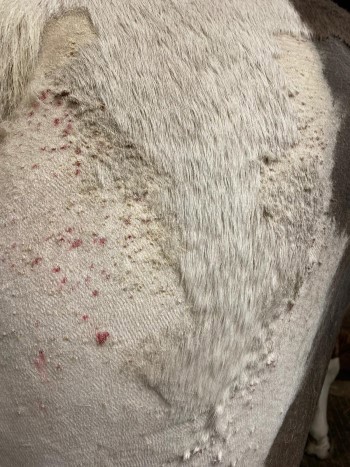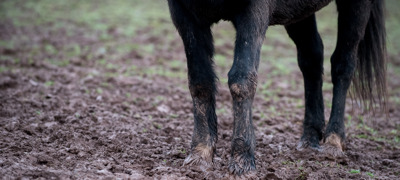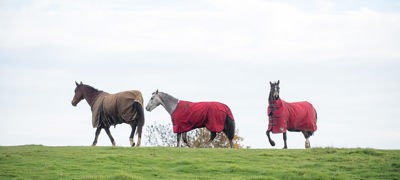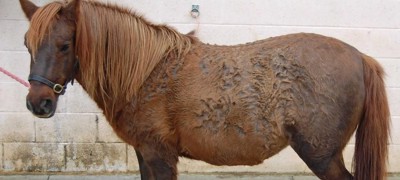Signs & diagnosis
The condition is often diagnosed in the autumn or winter months due to consistent exposure to wet and muddy conditions, although it is also seen when horses are over-rugged, as this can cause excessive sweating. Scabs form in places along the horse’s neck, back and hindquarters. Rain scald is characterised by these scabs coming off with tufts of hair, which look like little paint brushes.
Speak to your vet for advice if you think your horse has rain scald. It is important to confirm the signs are not mistaken for other skin conditions, such as ringworm which is a highly contagious fungal infection. Your vet may take a sample of the scab or do a skin scraping to help diagnose the condition under a microscope2.

Photo Credit: VetPartners - Ashbrook Equine Hospital
Treatment
Initially, the horse should be removed from the muddy, wet conditions, so you may need to provide adequate shelter or stabling.
The affected areas should be cleansed with a suitable antibacterial solution such as dilute Hibiscrub and then gently dried2. This will usually be needed daily until the area has healed. If the saddle area is affected, the horse may be unable to be ridden until it’s successfully treated.
After cleansing and drying, your vet may recommend the use of antibiotic creams. In severe cases horses may require oral antibiotics. Your vet will be able to determine the course of action and treatment plan most suitable for your horse.
Clipping away extremely thick hair can help in the treatment of the affected areas. Be aware that removing the scabs can be painful to the horse so sedation maybe required.
The bacteria in the scabs can cause re-infection so any grooming kit or tack should be appropriately disinfected.
Prevention
Prevention can be difficult as the UK often challenges us with difficult weather.
Shelter in the field, such as manmade structures or natural trees and hedges, can help reduce the risk of the skin being constantly wet, and infection occurring.
If your horse has a thin coat, is fully clipped or is underweight, rugging can also provide protection from the wet weather. However, horses that are over-rugged can become sweaty which makes the skin susceptible to infection, so make sure rugs are removed or reduced on mild days.
If possible, bring your horse inside for a time to allow the skin to dry and protect from prolonged wetting of the horse’s coat.
Appropriate grooming can remove any clumped areas of mud that can harbour bacteria underneath. When grooming field-kept horses, it’s important not to over-groom as you can remove the naturally protective oils in their coat.
Thoroughly inspecting the skin to identify early signs of rain scald is important and if there’s any concern, the vet should be contacted. Horses with a reduced immune function, such as those with Cushing’s Disease, are particularly susceptible to skin infections so treating anything underlying can reduce the risk of rain scald.
With thanks to VetPartners - Vicky Rowlands BVM&S CertEP MRCVS. Ashbrook Equine Hospital.
References
- XLVets (2022) Rain scald
- Rendle. D (2014) Managing bacterial and fungal dermatological issues in horses.






